Chapter: Principles of Compiler Design : Intermediate Code Generation
Intermediate Languages
INTERMEDIATE CODE GENERATION
INTRODUCTION
The front end
translates a source program into an intermediate representation from which the
back end generates target code.
Benefits of using a machine-independent intermediate
form are:
1.
Retargeting is facilitated. That is, a
compiler for a different machine can be created by attaching a back end for the
new machine to an existing front end.
2.
A machine-independent code optimizer can
be applied to the intermediate representation.

Fig.
3.1 Intermediate code generator
INTERMEDIATE LANGUAGES
Three ways of intermediate representation:
*
Syntax tree
*
Postfix notation
*
Three address code
The semantic rules for
generating three-address code from common programming language constructs are
similar to those for constructing syntax trees or for generating postfix
notation.
Graphical
Representations: Syntax tree:
A syntax tree depicts
the natural hierarchical structure of a source program. A dag (Directed Acyclic
Graph) gives the same information but in a more compact way because common
subexpressions are identified. A syntax tree and dag for the assignment
statement a : = b * - c + b * - c are shown in Fig.3.2:
Postfix notation:
Postfix notation is a
linearized representation of a syntax tree; it is a list of the nodes of the
tree in which a node appears immediately after its children. The postfix
notation for the syntax tree given above is
Syntax-directed definition:
Syntax trees for
assignment statements are produced by the syntax-directed definition.
Non-terminal S generates an assignment statement. The two binary operators +
and * are examples of the full operator set in a typical language. Operator
associativities and precedences are the usual ones, even though they have not
been put into the grammar. This definition constructs the tree from the input a
: = b * - c + b* - c.
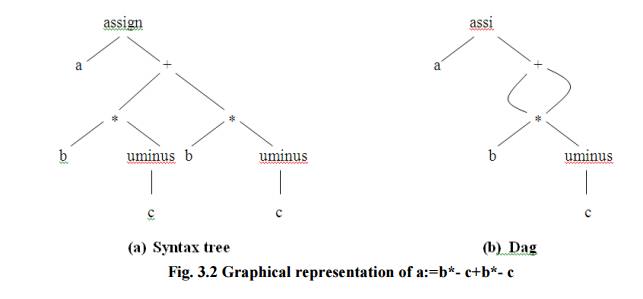
Fig.
3.2 Graphical representation of a:=b*- c+b*- c
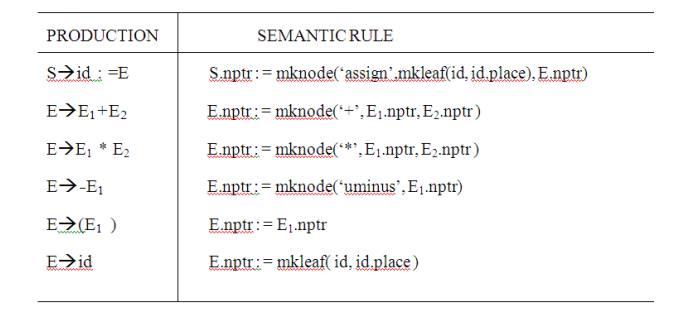
Fig.
3.3 Syntax-directed definition to produce syntax
The token id has an
attribute place that points to the symbol-table entry for the toen identifier.
A symbol-table entry can be found from an attribute id.name, representing the
lexeme associated with that occurrence of id. If the lexical analyzer holds all
lexemes in a single array of characters, then attribute name might be the index
of the first character of the lexeme.
Two representations of
the syntax tree are as follows. In (a) each node is represented as a record
with a field for its operator and additional fields for pointers to its
children. In (b), nodes
are allocated from an
array of records and the index or position of the node serves as the pointer to
the node. All the nodes in the syntax tree can be visited by following
pointers, starting from the root at position 10.
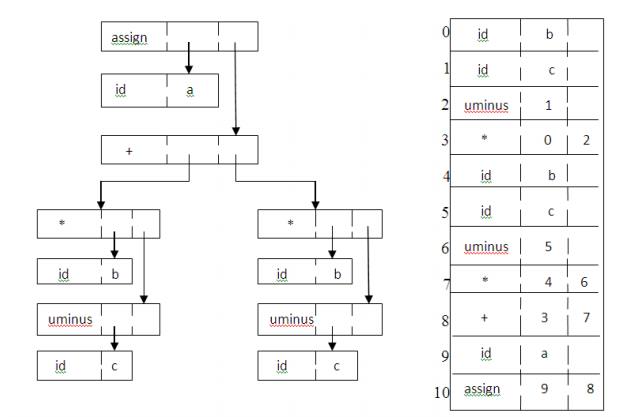
Fig.
3.4 Two representations of the syntax tree
Three-address code
Three-address code is a sequence of
statements of the general form x : = y op z
where x, y and z are
names, constants, or compiler-generated temporaries; op stands for any
operator, such as a fixed- or floating-point arithmetic operator, or a logical
operator on boolean-valued data. Thus a source language expression like x+ y*z
might be translated into a sequence

where t1 and t2 are compiler-generated temporary
names.
Advantages of three-address code:
* The unraveling of complicated arithmetic
expressions and of statements makes three-address code desirable for target
code generation and optimization. * The use of names for the intermediate
values computed by a program allows three-address code to be easily rearranged
- unlike postfix notation.
Three-address code is a
linearized representation of a syntax tree or a dag in which explicit names
correspond to the interior nodes of the graph. The syntax tree and dag are
represented by the three-address code sequences. Variable names can appear
directly in three address statements.

Fig.3.5
Three-address code corresponding to the syntax tree and dag
The reason for the term
“three-address code” is that each statement usually contains three addresses,
two for the operands and one for the result.
Types of Three-Address Statements:
The common three-address statements are:
1. Assignment
statements of the form x : = y op z, where op is a binary arithmetic or logical
operation.
2. Assignment
instructions of the form x : = op y, where op is a unary operation. Essential
unary operations include unary minus, logical negation, shift operators, and
conversion operators that, for example, convert a fixed-point number to a
floating-point number.
3. Copy
statements of the form x : = y where the value of y is assigned to x.
4. The
unconditional jump goto L. The three-address statement with label L is the next
to be executed.
5. Conditional
jumps such as if x relop y goto L. This instruction applies a relational
operator (<, =, >=, etc. ) to x and y, and executes the statement with
label L next if x stands in relation relop to y. If not, the three-address
statement following if x relop y as in the usual sequence.
6. param
x and call p, n for procedure calls and return y, where y representing a
returned value is optional. For example,

7.Indexed assignments of the form x : = y[i] and
x[i] : = y.
8.Address and pointer
assignments of the form x : = &y , x : = *y, and *x : = y.
Syntax-Directed Translation into
Three-Address Code:
When three-address code
is generated, temporary names are made up for the interior nodes of a syntax
tree. For example, id : = E consists of code to evaluate E into some temporary
t, followed by the assignment id.place : = t.
Given input a : = b * -
c + b * - c, the three-address code is as shown in Fig. 8.3a. The synthesized
attribute S.code represents the three-address code for the assignment S.
The nonterminal E has two attributes :
1. E.place,
the name that will hold the value of E , and
2. E.code,
the sequence of three-address statements evaluating E.
Syntax-directed definition to produce
three-address code for assignments
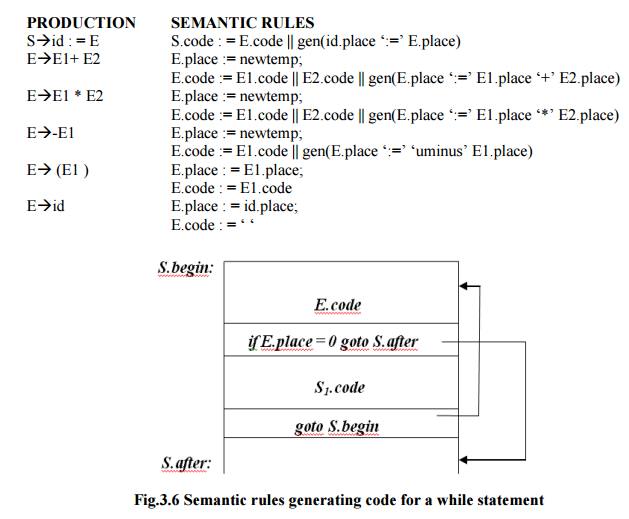
|
|
Fig.3.6 Semantic rules generating code
for a while statement
PRODUCTION
:
SEMANTIC RULES
S->whileEdoS1:
S.begin := newlabel;
S.after
:= newlabel;
S.code
:= gen(S.begin ‘:’) ||
E.code
||
gen
( ‘if’ E.place ‘=’ ‘0’ ‘goto’ S.after)|| S1.code ||
gen
( ‘goto’ S.begin) || gen ( S.after ‘:’)
The function newtemp
returns a sequence of distinct names t1,t2,….. in response to successive calls.
Ø
Notation gen(x ‘:=’ y ‘+’ z) is used to
represent three-address statement x := y + z. Expressions appearing instead of
variables like x, y and z are evaluated when passed to gen, and quoted
operators or operand, like ‘+’ are taken literally.
Ø
Flow-of-control statements can be added
to the language of assignments. The code for S
while E do S1 is generated using new attributes
S.begin and S.after to mark the first statement in the code for E and the
statement following the code for S, respectively.
The
function newlabel returns a new label every time it is called.
We assume that a non-zero expression represents
true; that is when the value of E becomes zero, control leaves the while
statement.
Implementation of Three-Address
Statements:
A three-address
statement is an abstract form of intermediate code. In a compiler, these
statements can be implemented as records with fields for the operator and the
operands. Three such representations are: Quadruples, Triples, Indirect triples
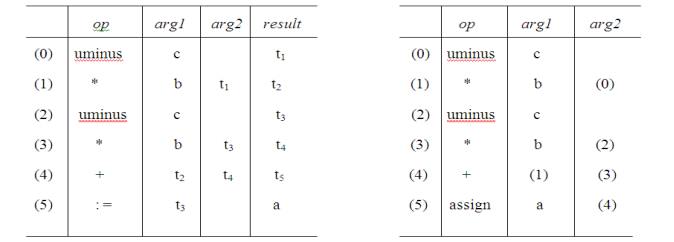
Fig.3.7
(a) Quadruples (b) Triples
Quadruples:
Ø
A quadruple is a record structure with
four fields, which are, op, arg1, arg2 and result.
Ø
The op field contains an internal code
for the operator. The three-address statement x : = y op z is represented by
placing y in arg1, z in arg2 and x in result.
Ø
The contents of fields arg1, arg2 and
result are normally pointers to the symbol- entries for the names represented
by these fields. If so, temporary names must be entered into the symbol table
as they are created.
Triples:
Ø
To avoid entering temporary names into
the symbol table, we might refer to a temporary value by the position of the
statement that computes it.
Ø
If we do so, three-address statements
can be represented by records with only three fields: op, arg1 and arg2.
Ø
The fields arg1 and arg2, for the
arguments of op, are either pointers to the symbol table or pointers into the
triple structure ( for temporary values ).
Ø
Since three fields are used, this
intermediate code format is known as triples.
A ternary operation
like x[i] : = y requires two entries in the triple structure while x : = y[i]
is naturally represented as two operations.

Fig.
3.8 (a) x[i] : = y (b) x : = y[i]
Indirect Triples:
Another implementation of three-address code is that
of listing pointers to triples, rather than listing the triples themselves.
This implementation is called indirect triples.
For example, let us use an array statement to list
pointers to triples in the desired order. Then the triples shown above might be
represented as follows:
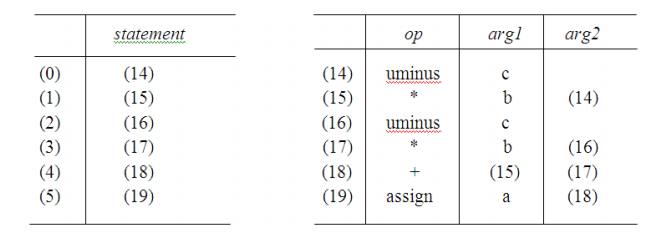
Fig.
3.9 Indirect triples representation of three-address statements
Related Topics